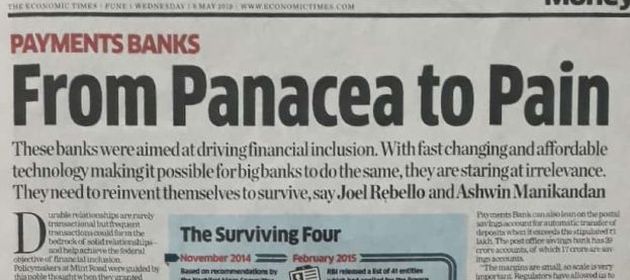When Payments Banks were launched in 2014-15, they were greeted with a lot of fanfare.
They were expected to bring hundreds of millions of unbanked Indians into the folds of organized financial services because their digital-only footprint would make it cost-effective from them to go to the rural hinterlands where traditional banks with branches have not gone before.
The disruptionistas predicted the digital natives to vibe with the needs and aspirations of Millennials and open the floodgates of a deluge of deposits from dowdy traditional banks.
Half a decade later, nothing of that sort has happened.
I can't think of another industry that has swung from euphoria to eulogy as rapidly as Payment Banks. https://t.co/tYJrTnPiYx
— Ketharaman Swaminathan (@s_ketharaman) May 16, 2016
According to the Times of India, “Payments banks have remained largely unsuccessful … (and have generated) total deposits of just under INR 540 crores”. Equivalent to $77M, that figure constitutes less than one hour of deposits at any leading traditional bank.
The Economic Times recently issued a dire warning about the viability of payments banks: “Payments banks, launched to make the country more financially inclusive, seems to be giving the regulators and investors a cause for concern as they continue with their second straight year of losses with little signs of turning the corner.”
In short, there’s a broad consensus that payments banks have flopped.
Why?
I have no inside track into the industry but I advance the following reasons to explain the lacklustre response received by payments banks.
#1. OVERESTIMATING MARKET
Payments banks were expected to have a readymade market of 233 million unbanked Indians.
No doubt that’s a huge number, but let’s break it down into various segments:
- People below poverty line. Do they need a bank account?
- People who have money but don’t have a bank account because they lack KYC documents. Such people can’t open accounts in payments banks either. Although they’re new-age digital-only banks, payments banks are subject to the same old KYC norms as traditional banks.
"Revolut charged with allegations over serious lapses in money laundering controls and dodgy hiring practices." ~ https://t.co/bctLsdK3VD via @Finextra .
Further proof that Fintechs can't beat banks at their own game if they need to follow the same rules as banks.— Ketharaman Swaminathan (@s_ketharaman) March 20, 2019
- People who have money but don’t have a bank account because bank officers mistreat them when they go to open an account at a traditional bank. I witnessed this personally when I accompanied my driver to open an account at a local bank. The banker shooed away my driver by asking him, “Why does a poor guy like you need a bank account?” He relented only when I stepped out from the sidelines and told him how much salary I pay my driver. Will this segment of people get any better treatment from payments banks?
Ergo, it’s questionable how many of the 233M unbanked Indians really form a part of payments banks’ TAM.
#2. UNDERESTIMATING BRANCH
There’s no doubt that people expect – and embrace – digital solutions for many their everyday needs e.g. ridesharing, food delivery, grocery, etc.
However, when it comes to their finances, people want physical presence. It appears that Branch And Digital Channels Will Coexist Forever. This is all the more true with people new to banking.
Copybook example of omnichannel banking:
"A customer can begin the search online, decide to buy on mobile – clear up some questions by phone – and finalize the purchase back on mobile."https://t.co/I46a312aKM via @McKinsey— GTM360 (@GTM360) March 7, 2019
Lacking physical branches, payments banks were unable to provide the comfort required to attract a critical mass of the unbanked, which was envisaged to be their primary market.
#3. OVERESTIMATING DIGITAL
People sign up for digital services by blindly clicking the “I Agree” button on websites and apps.
When $sh*t happens on social networks, ridesharing, food delivery, and other digital services, most people ignore them and move on. Even when the media raises hell, as in the case of the Facebook-Cambridge Analytica data breach, the average user is largely unperturbed.
However, when the same thing happens in digital banking, people raise a huge hue-and-cry. Social networks whip up frenzy. Mainstream media adds fuel to the fire. Regulators rap financial institutions’ knuckles. CEOs lose their jobs.
We saw an example of this when Airtel automatically onboarded its mobile phone customers to its payments bank.
Going by this screen, Airtel Payments Bank has obtained the required consent for opening an account. For a digital bank, a check in the box and tap of I AGREE button should be sufficient proof of "informed consent". Nobody's going to explain fineprint face-to-face. pic.twitter.com/OKdbjZkOWs
— GTM360 (@GTM360) April 30, 2019
Regardless of what I think, the average banking customer *does* expect someone to explain fineprint in person. And, if they don’t, they cry fraud, and regulators hear them.
Purely digital approaches like checkboxes and buttons backfire in banking, as payments banks have learned the hard way.
That’s not to say all is lost.
There are still niches in the market where payments banks have a strong value proposition. More on that in a follow-on post. Watch this space!
